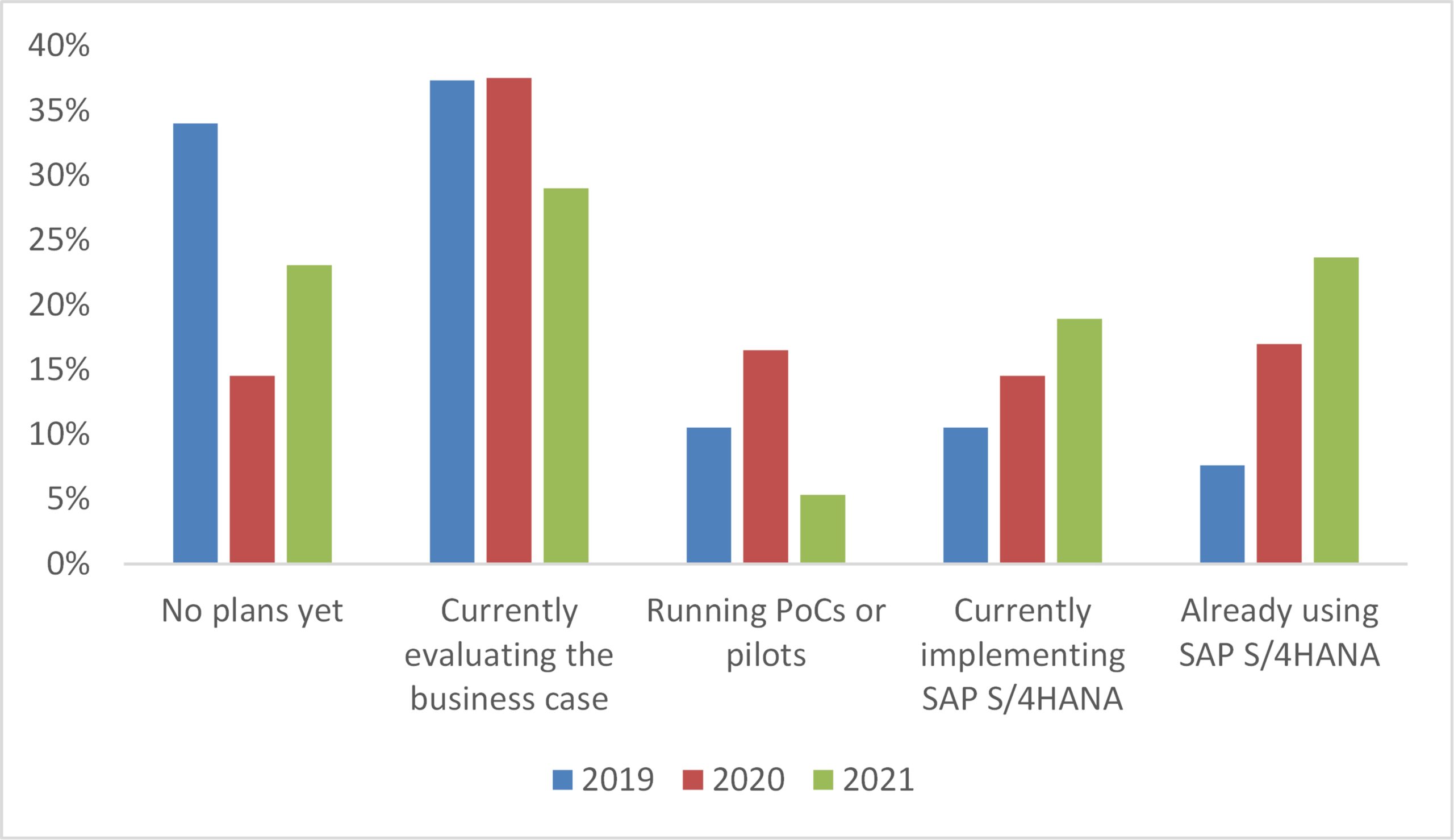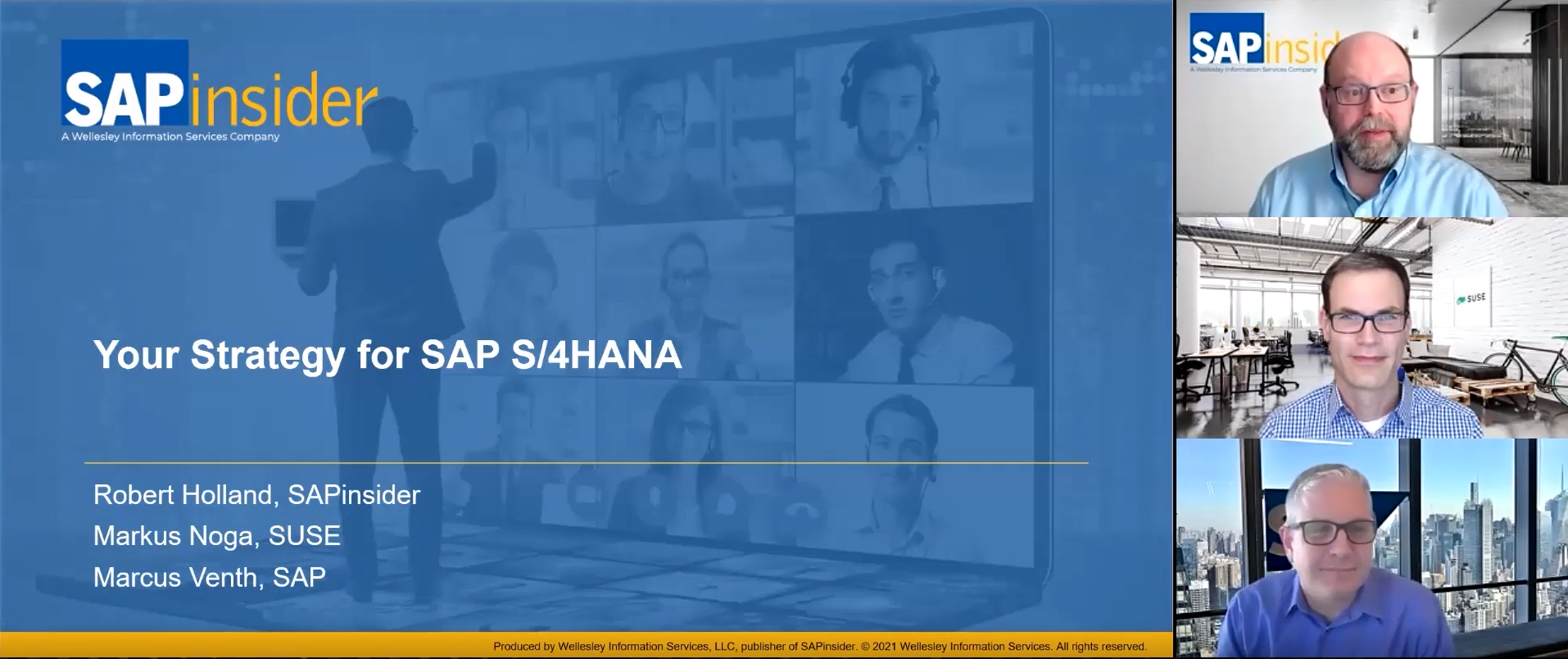The Road to SAP S/4HANA
Live Chat on Migration Best Practices and Roadmap
Panelists: Carl Dubler, Sobana Iyengar, and Ranjeet Panicker
Sponsor: SAP
SAP S/4HANA provides the opportunity for IT to lead digital transformation efforts. With SAP S/4HANA, IT can not only improve its own operations, but also deploy technology innovation to bring transformation and productivity gains to the business.
If you haven’t already, subscribe to SAPinsider Online for free today!
Matthew Shea: Hello, and welcome to today’s chat on SAP S/4HANA with SAP’s Carl Dubler, Sobana Iyengar, and Ranjeet Panicker.
Carl Dubler is Senior Director of SAP S/4HANA Product Marketing at SAP. With an IT career stretching back to the late 1980s, he has done nearly every role in the business. In his 10 years at SAP, he also managed SAP’s first cloud product built on SAP HANA.
Sobana Iyengar is the SAP S/4HANA Practice Lead at the SAP Digital Transformation Office. She has been with SAP for the past 11 years and is responsible for the end-to-end business, including pre-sales, value design, design support, and solution architecture.
Ranjeet Panicker leads the SAP S/4HANA services portfolio team and is responsible for topics around SAP S/4HANA technology and platform. Ranjeet has been with SAP for 10 years and has broad experience across various databases and platforms, having been in the field as a platinum consultant and then having managed the North American OS/DB and migration services. He is currently the service delivery owner for SAP Business Warehouse (SAP BW), SAP ERP Central Component (ECC), and SAP S/4HANA migration plus conversion services for Digital Business Services in North America. He is based in Austin, Texas.
We have an overarching question to start the chat. What are the requirements to do a system conversion from SAP ECC 6.x to SAP S/4HANA?
Carl Dubler: You can start with ECC 6, any enhancement package (EHP). Unicode is required. The best way to see exactly what you will need to do for any system conversion is to run the free Readiness Check tool. Read this blog for more information.
Ezekiel: What is Readiness Check?
Carl Dubler: Readiness Check is a free tool for SAP customers that provides personalized, technical guidance for a system conversion to SAP S/4HANA. A customer loads their system configuration and usage data and the resulting reports are delivered via a private cloud portal and includes information on sizing, code compatibility, 3rd-party add-on compatibility, and several other technical categories.
Comment From Varda: Is it possible to migrate one of our sandbox ECC systems to SAP S/4HANA with an evaluation license and experience SAP S/4HANA and understand the challenges before we finalize the roadmap to SAP S/4HANA ?
Carl Dubler: Yes, there are lots of choices for this, including running a test system on Azure or Amazon Web Services (AWS). Go to the SAP Cloud Appliance Library for more information.
Comment From Varda: What does the SAP S/4HANA migration project landscape look like? Do we build SAP S/4HANA skeleton systems first and then move the data from existing systems? Then once all processes and data are set up correctly on the SAP S/4HANA landscape, do we go live?
Ranjeet Panicker: In an SAP S/4HANA system conversion, you will typically create an N + 1 system for development (DEV) and quality assurance (QAS).
For test conversions you will create a staging or sandbox system from a copy of production and go through test cycles.
The process for the production system is a cutover from the old production ECC system to the new SAP S/4HANA system during the conversion cutover weekend.
Comment From James: What is the best path of study to get our ABAP programmers transitioned for development in SAP S/4HANA to reduce our need for outside consulting?
Carl Dubler: The major change is to understand the data model of SAP S/4HANA and how to take best advantage of it. I’d recommend taking the time to view this recorded presentation on ABAP strategy and SAP S/4HANA.
Comment From Lorena: Hi, we have recently acquired a new company that has SAP S/4HANA on premise, and when I tried to execute the transaction codes FF7A (Cash Position) and FF7B (Liquidity Forecast), it seems that they are not available. So do these transactions need a special additional license?
Sobana Iyengar: An SAP S/4HANA Enterprise Management license covers the transactions related to Liquidity Forecast. Only SAP Bank Communication Management requires an additional license. Here is a list of the transactions involving SAP Bank Communication Management:
- Maintaining House Bank Accounts (formerly FI12)
- Basic Cash Position and Basic Liquidity Forecast (FF7AN, FF7BN)
- Memo Records (FF63 and FF65)
- Basic Cash Concentration (FF73)
- Import of Electronic Bank Statements (FF.5).
Comment From Marco Rojas: Can all data in SAP R/3 be migrated to SAP S/4HANA?
Carl Dubler: Because SAP S/4HANA has a simplified data model, some things might need to be adapted. The best way to understand what can be migrated and what needs to be adapted to the new data model is to run Readiness Check. For more information read this blog on Readiness Check.
Comment From Varsha: Is there any new setup for security and authorization (in terms of new SAP transactions compared with ECC security) concepts that need to be considered for SAP S/4HANA?
Ranjeet Panicker: In a system conversion scenario you will analyze the system based on the SAP S/4HANA Readiness Check to identify any obsolete transaction codes or new transaction codes and adjust these roles.
You will also identify and create any new SAP Fiori roles depending on users who will access SAP S/4HANA via SAP Fiori instead of via the SAP GUI.
Comment From Edwin: Can we migrate both a “normal” ECC instance and an instance with SAP I/S Retail installed on it into a single SAP S/4HANA instance?
Carl Dubler: SAP S/4HANA supports consolidating instances into one on SAP HANA. Whether you decide to do this or not will be up to the business and technical requirements you have, but it is a good opportunity to consider consolidation.
Comment From Elijah: How can I tell which business processes have been “simplified”?
Carl Dubler: My favorite way to view this is by using the new Innovation Discovery tool since it is a friendly way to browse by business process and industry: https://go.support.sap.com/innovationdiscovery/ (Log in required)
If you’d rather view the entire list of changes, you can do that, but it can get a bit overwhelming: Simplification List for SAP S/4HANA 1709 (PDF)
If you are looking to do a system conversion from an ECC 6.x system, then the Readiness Check tool is a great way to get very specific information on the simplifications that will affect your exact deployment. For more information read this blog.
Comment From Eddie: Please discuss best practices for migrating from ECC 6.0 to SAP S/4HANA specifically from an SAP Financial Accounting (FI) mindset? Thanks in advance.
Ranjeet Panicker: The detailed process to analyze FI topics are mentioned in SAP Note 2332030 – Conversion of accounting to SAP S/4HANA. Please download the attachment with this note “Converting Your Accounting Components to SAP S/4HANA.”
The guide will give you all the details on prerequisites as well steps during the conversion: https://launchpad.support.sap.com/#/notes/2332030 (Log in required)
Comment From Deniz: Do we need new G/L (the SAP General Ledger) implementation to support a split in SAP S/4HANA?
Sobana Iyengar: Yes. Document splitting is part of the SAP General Ledger. Document splitting is optional to activate. However, the SAP General Ledger is mandatorily activated in SAP S/4HANA.
Comment From Ruth: Do we need to go to “Suite on SAP HANA” as a step to full SAP S/4HANA?
Carl Dubler: No, you don’t! You can go directly to SAP S/4HANA from ECC 6.x, any EHP. There isn’t a technical reason to do the Suite on SAP HANA step any more – that came from the early days of SAP S/4HANA prior to the 1511 release.
Comment From Ed: Can we do a system conversion to SAP S/4HANA and move to the cloud at the same time?
Carl Dubler: Yes, if the cloud destination is SAP HANA Enterprise Cloud (HEC) including our infrastructure as a service (IaaS) partners. If the destination is the public cloud version of SAP S/4HANA, then you migrate the data, but don’t do a system conversion.
Comment From Jeremiah: Do we need to modify all our custom code to get it to work with SAP S/4HANA?
Carl Dubler: There will probably be some custom code that needs to be adapted, but not likely all of it. You can find out for sure by running Readiness Check.
Comment From Deniz: Is migration supported from special-purpose ledgers (ECC) to SAP S/4HANA? Or can the data source be from FI and Controlling (CO), such as BSEG and COEP?
Sobana Iyengar: System conversion to SAP S/4HANA will handle the special-purpose ledgers. For a new implementation one can use the function of parallel ledgers.
Comment From Terry Chadwick: What needs to be considered regarding custom code when migrating from ECC 6.x to SAP S/4HANA?
Carl Dubler: See my reply to Jeremiah above. Readiness Check can help you determine what custom code will need to be adapted. I also recommend running the Custom Code Lifecycle Management (CCLM) tools to determine what custom code you have now that is not being used anymore. The more obsolete code you can get rid of prior to a system conversion, the easier it will be for you. Our experience with SAP S/4HANA so far indicates that about 60 percent of custom code out there is no longer in use.
Comment From James: If I wanted to become a consultant doing development with SAP S/4HANA, what will be the hottest skill sets with the highest demand going forward?
Carl Dubler: It is a good time to be in the ERP game now, as SAP S/4HANA is providing the biggest opportunity we’ve had in a decade. There are certainly new things to learn, such as the simplified data model, Fiori development, and the growing demand for IoT (SAP Leonardo). However, success as a consultant is still the same: It requires knowledge of the business processes of your clients and how to map them to what SAP S/4HANA does. I think the trend for many SAP customers will be a return to standardized processes wherever possible. A great presentation to watch on the subject of development and SAP S/4HANA is available here:
Comment From Varda: Does SAP S/4HANA have all the functionalities of an SAP Supplier Relationship Management (SAP SRM) system and can an SAP SRM application be decommissioned after migrating to SAP S/4HANA?
Carl Dubler: SAP S/4HANA sourcing and procurement is definitely the way forward. The old SAP SRM 7 will still be on mainstream maintenance until 2025, however, to allow for adequate time to transition. I recommend watching this two-minute video overview to understand the differences.
Comment From Hernando: Are steps to migrate from version 6.08 to SAP S/4HANA already included in the entire vertical SAP for Oil and Gas, and can we migrate to the cloud directly?
Carl Dubler: SAP for Oil and Gas is part of SAP S/4HANA as of the 1610 release (October 2016). So, yes, you can take that functionality to SAP S/4HANA today. Whether you go directly to the cloud or not is a different issue. See my reply to Ed’s question above. But basically, you can do a system conversion to SAP HANA Enterprise Cloud, including our IaaS partners such as Azure and AWS.
Comment From Andres B: If we have SAP Business Planning and Consolidation (SAP BPC) with SAP BW without SAP HANA, what is the better migration option? Should we migrate to SAP BW/4HANA? Should we Implement SAP S/4HANA?
Sobana Iyengar: Both options work. It depends on requirements whether one needs a standalone SAP BPC or the embedded version in SAP S/4HANA. Refer to SAP Note 2450774 -SAP Business Planning and Consolidation 11.0, version for SAP BW/4HANA SP00 Central Note.
Comment From Guest: We are on ECC 6 EHP 7 and the downtime requirement is only seven hours. Can we use near-zero downtime (NZDT)? If yes, what is the procedure to engage SAP? We are planning to go to SAP S/4HANA in mid 2018.
Carl Dubler: For an overview of the NZDT process, I recommend checking out this presentation from TechEd 2017.
Ranjeet can provide more information on how to engage with SAP on this. Earlier in the year at our SAPPHIRE conference, WalMart did a presentation on its NZDT experience.
Here is the WalMart presentation on its NZDT SAP S/4HANA deployment.
Ranjeet Panicker: For NZDT, refer to SAP Note 693168 – Minimized Downtime Service (MDS) for details or alternatively send your request or questions about the “Minimized Downtime Service” to the following email address: mds@sap.com. Please include the completed Minimized Downtime Service Questionnaire that is attached to this note. https://launchpad.support.sap.com/#/notes/693168 (Log in required).
Comment From Varda: Is SAP Integrated Business Planning part of the latest versions of SAP S/4HANA already, or do you have plan to make SAP Integrated Business Planning available on SAP S/4HANA by default so that customers don’t need to have separate SAP Integrated Business Planning systems?
Sobana Iyengar: Information on this topic is available here.
Comment From Jay: How can SAP S/4HANA best be positioned to connect to SAP Integrated Business Planning?
Carl Dubler: SAP Integrated Business Planning is such a big topic, and the product has several independent components. The key is to understand the priorities of the business and get that up and running first, whether it is sales and operations planning (S&OP), demand planning, or something else. Also, since SAP Integrated Business Planning is cloud based, that could be a transition for some organizations, and the knowledge of SAP HANA Cloud Integration will be important. There’s a very good SAP Integrated Business Planning community online. To visit this community, click here.
Carl Dubler: If you haven’t had a chance yet to see what is in the latest SAP S/4HANA release (SAP S/4HANA 1709), be sure to check out the following article. We are on our fourth major release now.
Comment From Saul: How many customers are on SAP S/4HANA?
Carl Dubler: There are over 6,800 customers who are in various stages of SAP S/4HANA deployment. Over 1,000 of them are already live. You can also see a lot of customer stories and videos here.
Comment From Varsha: How is SAP GRC aligned with the road to SAP S/4HANA from a compliance perspective?
Carl Dubler: The full SAP GRC portfolio works great with SAP S/4HANA. There is nothing really that needs to be aligned for it to work. I hope this is what you were asking in your question.
Comment From Kenny: We use consolidations at the most basic level here. Are all consolations now part of SAP BPC that have to be purchased as a separate license, or is there any part of consolidation still left from the ECC world that will be part of an SAP S/4HANA basic license?
Sobana Iyengar: The ECC world is not part of SAP S/4HANA. The following reference provides the options and the license information.
Comment From Jay: What is the best way to move global available to promise (global ATP) from SAP Advanced Planning and Optimization (SAP APO) to SAP S/4HANA? What are some things to watch for during this transition?
Carl Dubler: In general, the strategy is for advanced ATP to go back to the core in SAP S/4HANA. I know we have some guidance on how to make this move from global ATP, but I can’t seem to locate it at this moment. If you want, send me an email directly and we’ll track it down: carl.dubler@sap.com.
Carl Dubler: Before we close the conversation, I noticed today we have published 75 recorded sessions from TechEd 2017. If you weren’t able to attend, viewing these replays is a great way to get the latest technical presentations on a variety of subjects.
Matthew Shea: Thank you, Carl, Sobana, and Ranjeet. And thanks to everyone who asked a question.








